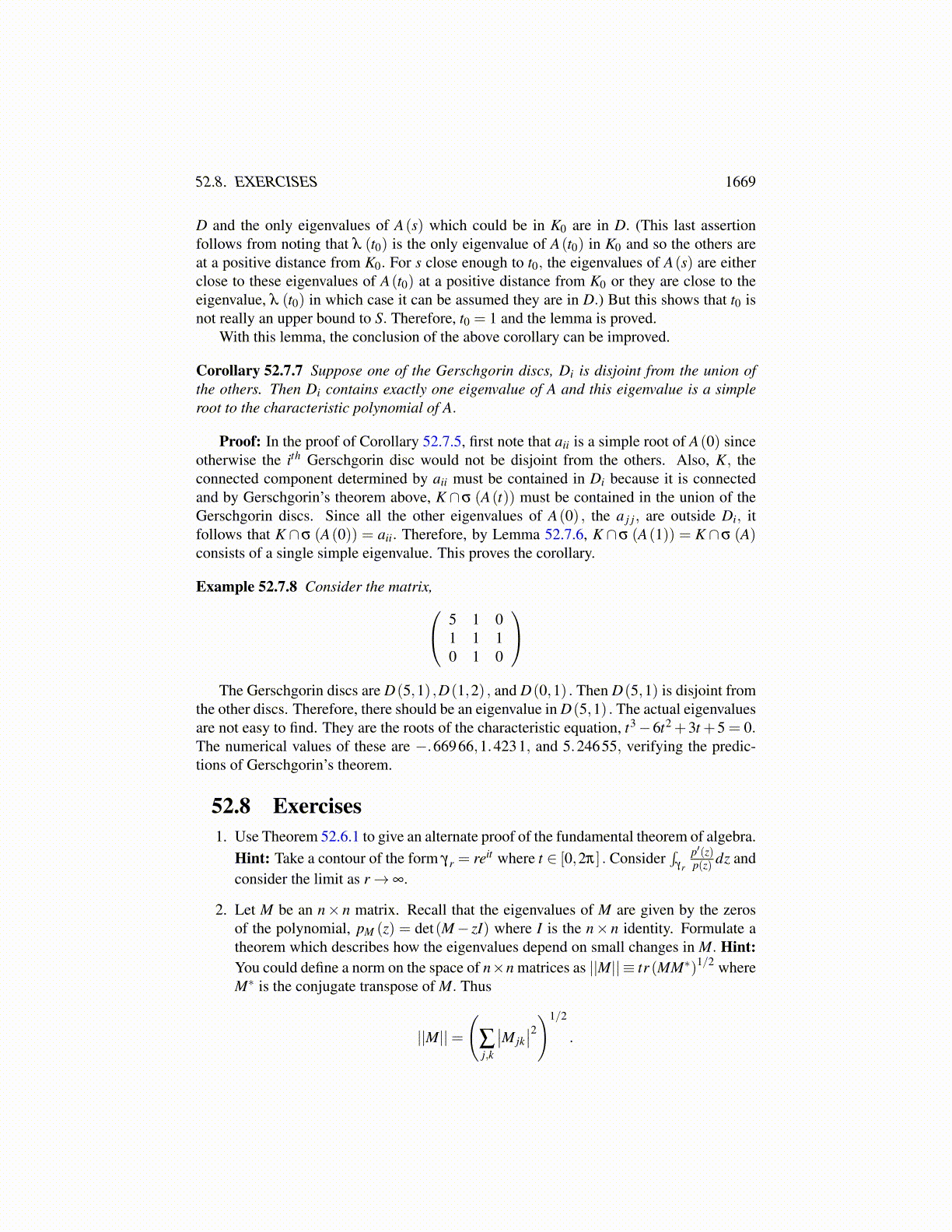
52.7. AN APPLICATION TO LINEAR ALGEBRA 1669
same number of eigenvalues, counted according to multiplicity, in the disc as A(t) . Thusσ (A(s))∩D(λ (t) ,δ ) ̸= /0 for all s ∈ [t, t +η ] . Now let
H =⋃
s∈[t,t+η ]
σ (A(s))∩D(λ (t) ,δ ) .
I will show H is connected. Suppose not. Then H = P∪Q where P,Q are separated andλ (t) ∈ P. Let
s0 ≡ inf{s : λ (s) ∈ Q for some λ (s) ∈ σ (A(s))} .
There exists λ (s0)∈ σ (A(s0))∩D(λ (t) ,δ ) . If λ (s0) /∈Q, then from the above discussionthere are
λ (s) ∈ σ (A(s))∩Q
for s > s0 arbitrarily close to λ (s0) . Therefore, λ (s0) ∈Q which shows that s0 > t becauseλ (t) is the only element of σ (A(t)) in D(λ (t) ,δ ) and λ (t) ∈ P. Now let sn ↑ s0. Thenλ (sn) ∈ P for any
λ (sn) ∈ σ (A(sn))∩D(λ (t) ,δ )
and from the above discussion, for some choice of sn→ s0, λ (sn)→ λ (s0) which contra-dicts P and Q separated and nonempty. Since P is nonempty, this shows Q = /0. Therefore,H is connected as claimed. But Kt ⊇ H and so Kt ∩σ (A(s)) ̸= /0 for all s ∈ [t, t +η ] . Thisproves the lemma.
The following is the necessary theorem.
Theorem 52.7.4 Suppose A(t) is an n× n matrix and that t → A(t) is continuous fort ∈ [0,1] . Let λ (0) ∈ σ (A(0)) and define Σ≡ ∪t∈[0,1]σ (A(t)) . Let Kλ (0) = K0 denote theconnected component of λ (0) in Σ. Then K0∩σ (A(t)) ̸= /0 for all t ∈ [0,1] .
Proof: Let S ≡ {t ∈ [0,1] : K0∩σ (A(s)) ̸= /0 for all s ∈ [0, t]} . Then 0 ∈ S. Let t0 =sup(S) . Say σ (A(t0)) = λ 1 (t0) , · · · ,λ r (t0) . I claim at least one of these is a limit pointof K0 and consequently must be in K0 which will show that S has a last point. Why is thisclaim true? Let sn ↑ t0 so sn ∈ S. Now let the discs, D(λ i (t0) ,δ ) , i = 1, · · · ,r be disjointwith pA(t0) having no zeroes on γ i the boundary of D(λ i (t0) ,δ ) . Then for n large enough itfollows from Theorem 52.6.1 and the discussion following it that σ (A(sn)) is contained in∪r
i=1D(λ i (t0) ,δ ). Therefore, K0∩ (σ (A(t0))+D(0,δ )) ̸= /0 for all δ small enough. Thisrequires at least one of the λ i (t0) to be in K0. Therefore, t0 ∈ S and S has a last point.
Now by Lemma 52.7.3, if t0 < 1, then K0∪Kt would be a strictly larger connected setcontaining λ (0) . (The reason this would be strictly larger is that K0 ∩σ (A(s)) = /0 forsome s ∈ (t, t +η) while Kt ∩σ (A(s)) ̸= /0 for all s ∈ [t, t +η ].) Therefore, t0 = 1 and thisproves the theorem.
The following is an interesting corollary of the Gerschgorin theorem.
Corollary 52.7.5 Suppose one of the Gerschgorin discs, Di is disjoint from the union ofthe others. Then Di contains an eigenvalue of A. Also, if there are n disjoint Gerschgorindiscs, then each one contains an eigenvalue of A.